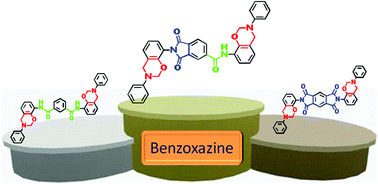An anomalous trade-off effect on the properties of smart ortho-functional benzoxazines
Abstract
A series of ortho-difunctional benzoxazine monomers containing amide, imide and amide–imide groups have been synthesized in order to obtain basic design rules toward preparing higher performance polybenzoxazoles based on smart benzoxazine chemistry. The structures of the synthesized monomers have been confirmed by 1H nuclear magnetic resonance spectroscopy (NMR) and Fourier transform infrared spectroscopy (FTIR). The polymerization behavior of benzoxazine monomers is studied by differential scanning calorimetry (DSC). The trade-off between a symmetric imide and a symmetric amide results in an asymmetric amide–imide functional monomer exhibiting the broadest processing window and the lowest activation energy of the ortho-functional benzoxazines studied. After polymerization, the thermal stability of each polybenzoxazine is studied by thermogravimetric analysis (TGA). The polymer obtained from ortho-(amide–imide) functional benzoxazine gives the highest thermal stability, which is against the traditionally designed poly(amide-co-imide), possessing the thermal stability between polyamide and polyimide. The activation energy for benzoxazine polymerization and the degradation of polybenzoxazole are also studied by DSC and TGA, respectively. The relationship between the benzoxazine monomer structures and the thermoset properties has been discussed.


 Please wait while we load your content...
Please wait while we load your content...